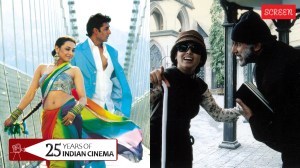Man who sees tomorrow says the future is now
Do you have trouble sticking to a diet? Have patience. Within 10 years, Dr Ray Kurzweil explained at the World Science Festival in New York last week...

Do you have trouble sticking to a diet? Have patience. Within 10 years, Dr Ray Kurzweil explained at the World Science Festival in New York last week, there will be a drug that lets you eat whatever you want without gaining weight.
Worried about greenhouse gas emissions? Have faith. Solar power may look terribly uneconomical at the moment, but with the exponential progress being made in nanoengineering, Dr. Kurzweil calculates that it’ll be cost-competitive with fossil fuels in just five years, and that within 20 years all our energy will come from clean sources.
Are you depressed by the prospect of dying? Well, if you can hang on another 15 years, your life expectancy will keep rising every year faster than you’re ageing. And then, before the century is even half over, you can be around for the Singularity, that revolutionary transition when humans and/or machines start evolving into immortal beings with ever-improving software.
At least that’s Dr. Kurzweil’s calculation. It may sound too good to be true, but even his critics acknowledge he’s not your ordinary sci-fi fantasist. He is a futurist with a track record and enough credibility for the National Academy of Engineering to publish his sunny forecast for solar energy.
He makes his predictions using what he calls the Law of Accelerating Returns, a concept he illustrated at the festival with a history of his own inventions for the blind. In 1976, when he pioneered a device that could scan books and read them aloud, it was the size of a washing machine.
Two decades ago he predicted that “early in the 21st century” blind people would be able to read anything anywhere using a handheld device. In 2002 he narrowed the arrival date to 2008. On Thursday night at the festival, he pulled out a new gadget the size of a cellphone, and when he pointed it at the brochure for the science festival, it had no trouble reading the text aloud.
This invention, Dr. Kurzweil said, was no harder to anticipate than some of the predictions he made in the late 1980s, like the explosive growth of the Internet in the 1990s and a computer chess champion by 1998. (He was off by a year — Deep Blue’s chess victory came in 1997.)
“Certain aspects of technology follow amazingly predictable trajectories,” he said, and showed a graph of computing power starting with the first electromechanical machines more than a century ago. At first the machines’ power doubled every three years; then in midcentury the doubling came every two years; now it takes only about a year.
Now, Dr Kurzweil sees biology, medicine, energy and other fields being revolutionised by information technology. His graphs already show the beginning of exponential progress in nanotechnology, in the ease of gene sequencing, in the resolution of brain scans. With these new tools, he says, by the 2020s we’ll be adding computers to our brains and building machines as smart as ourselves.
This serene confidence is not shared by neuroscientists like Vilayanur S. Ramachandran, who discussed future brains with Dr. Kurzweil at the festival. It might be possible to create a thinking, empathetic machine, Dr. Ramachandran said, but it might prove too difficult to reverse-engineer the brain’s circuitry because it evolved so haphazardly.
He is accustomed to this sort of pessimism and readily acknowledges how complicated the brain is. “Scientists imagine they’ll keep working at the present pace,” he said.



- 01
- 02
- 03
- 04
- 05




























